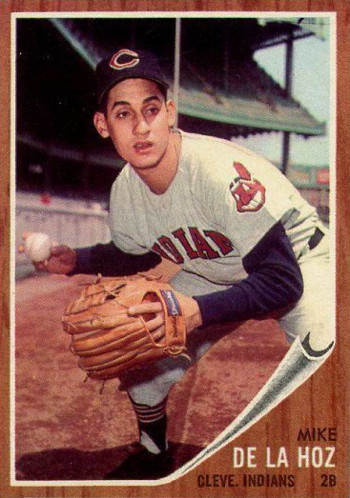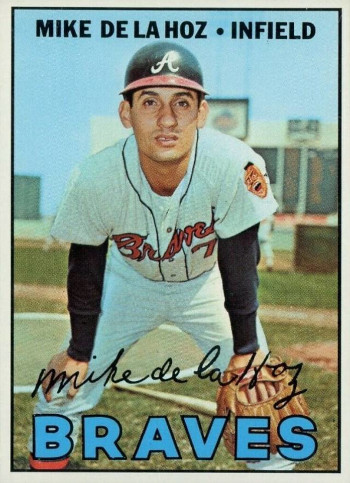RIP to Miguel de la Hoz, a utility infielder during much of the 1960s and a member of the first Atlanta Braves team. He died on May 28 in Miami, where he had spent the last six months in hospice care. He was 84 years old. Islander News reported that de la Hoz, always the baseball fan, was watching the Miami Marlins almost right up to his last moments on earth. De la Hoz played for the Cleveland Indians (1960-63), Milwaukee/Atlanta Braves (1964-67) and Cincinnati Reds (1969).
Miguel Angel de la Hoz was born on October 2, 1938, in San Nicolás de Bari, Cuba. Baseball Reference states that he went to Guines High School in Havana. He left Cuba in 1958, according to Island News, just ahead of the start of the Castro regime. He had been a part of the famed Almendares team in the country’s baseball league. When he was signed by Cleveland by scout Julio “Monchy” de Arcos (hat tip to Rod Nelson of the SABR Scouts Committee), his parents told him not to come back to Cuba, out of fear that he would never be able to leave again. De la Hoz later was reunited with his parents when they were able to get visas and come to the United States. They all settled in the Miami area.

Going back to 1959, though, the 20-year-old de la Hoz was assigned to Minot (Montana) of the Northern League. He was among the league leaders in hitting for much of the season, though he eventually tailed off to a still-impressive .315 batting average. He scored 95 runs and drove in another 62 runs, though he hit only 6 homers. He moved up to Class-A Reading of the Eastern League in 1959 and popped 15 home runs while batting .295. The power numbers were a career-high and a bit of an aberration, as he reached double digits in home runs just twice in his professional career and never in the major leagues. But for the most part, he hit well in the minors. De la Hoz (usually referred to as “Mike” in newspaper articles — part of an Americanization of Latin American ballplayers that sometimes turned Roberto Clemente into “Bob Clemente”) was considered a top prospect in 1960 and was brought to the major leagues in July. He was immediately plugged into the role of starting shortstop, replacing an injured Woodie Held. He singled in his first major-league game against Boston’s Ike Delock on July 22, 1960. A day later, he drove in 2 runs in a 4-2 Cleveland victory, including a solo homer off Tom Brewer. A day after that, he drove in 3 runs in a losing effort during the second game of a doubleheader against the Red Sox. De la Hoz kept his batting average up over .300 for several weeks before cooling down to a .256 mark in 49 games. However, he slugged at a .431 clip and homered in three consecutive games from September 14-17. He also drove in 6 sacrifice flies, which was enough to finish in ninth place in the AL. He lost his job at shortstop once Held returned, but the versatile de la Hoz moved to third base to finish the year.
De la Hoz never played in more than 100 games in a season in the majors. However, he stuck with Cleveland for several seasons as a backup infielder. In 1961, he played 17 games at second base, 17 at shortstop and 16 at third base. His fielding was a little under league average, but he had very good range, particularly at shortstop. He was also a handy bat off the bench. De la Hoz slashed .260/.295/.370 in 61 games in 1961. For the second consecutive season, he drove in 23 runs and scored 20 times. In the offseason, he played winter ball in Puerto Rico and won the league’s batting title with a .354 batting average. However, when he came to Cleveland for 1962, he had nowhere to play. New manager Mel McGaha set his infield with Tito Francona, Jerry Kindall, Held and Bubba Phillips, and he hardly took them out of the lineup. De la Hoz had just 12 pinch-hit at-bats with 1 single through early June and was then sent to Jacksonville of the International League.

De la Hoz regained his usual playing time with Cleveland in 1963, under another new manager, Birdie Tebbetts. He was primarily a second baseman but also played a little at shortstop, third base and left field. The versatility didn’t always work. Tebbetts overthought the second half of a doubleheader against the Yankees on July 7. He switched second baseman de la Hoz and shortstop Kindall several times throughout the game, hoping to gain some fielding advantage. Instead, de la Hoz committed 3 errors in the game, allowing 4 unearned runs to score in a 7-4 Yankees win. One of them came right after de la Hoz had moved to shortstop in the top of the 10th inning. Jack Reed hit a ground ball to him, but de la Hoz threw wildly to first base, letting Yogi Berra and Joe Pepitone score a pair of insurance runs. De la Hoz had a much better doubleheader against Detroit on September 1. He hit a grand slam in the first inning of the first game against Don Mossi, as the Indians cruised to a 6-3 win. He then went 3-for-3 in the second game, which Cleveland won by a score of 3-1. He did commit an error at third base on an Al Kaline grounder, but Cleveland starter Pedro Ramos got out of the inning unscathed.
In October of 1963, the Milwaukee Braves traded infielder Chico Salmon to Cleveland for a player to be named later. About six months later, it was announced that De la Hoz was that player. He spent four seasons with the Braves, the first two in Milwaukee and the second two in Atlanta. During that time, he was one of the team’s top pinch-hitters. De la Hoz, a right-handed hitter, and lefty outfielder Ty Cline were usually the first bats to come off the bench. According to Baseball Reference’s batting splits for de la Hoz, he was a career .185 pinch-hitter, with 4 home runs and 13 RBIs. However, it also shows that he was a career .276 hitter in high-leverage situations, which is defined as game situations that could dramatically affect the win probability of the game. De la Hoz was a valuable hitter in the clutch.
In de la Hoz’s first season in Milwaukee, he batted .291 in 78 games, with a career-high 55 hits and 25 runs scored. He also played some solid defense, particularly at second base. In one June 4 game against Cincinnati, de la Hoz took part in two double plays and a triple play, giving him two putouts and 7 assists at second base. His first National League homer came on July 5 against Ernie Broglio of the Cubs, and it helped pace Milwaukee to a 5-1 win — starter Wade Blasingame threw a complete game for the first of his 46 career wins. De la Hoz reached a career high with 81 games played in 1965, and though his batting average slipped to .256, he had some clutch hits. He hit a game winning sacrifice fly against Cincinnati in the eleventh inning on September 2, 1965. He drove in Eddie Mathews, who had singled and reached third base when reliever Ted Davidson threw wildly on a sacrifice bunt. De la Hoz then came up as a pinch-hitter and hit a deep fly, easily scoring the final run in a 4-3 Braves win. “I wish he had hit the ball just a bit harder,” said Mathews. “I would not have had to run so fast.” The game was especially painful for Cincinnati, which fell out of a first-place tie in the NL West and never recovered.

The Braves moved to Atlanta in 1966, and de la Hoz spent two seasons with the team. He batted .218 in 1966 and .203 in ’67. His final bit of late-inning heroics came on September 14 against the New York Mets. The Mets were leading 4-3 with Dick Selma on the mound, heading into the bottom of the ninth inning. Henry Aaron walked and Mack Jones reached on a bunt attempt that was mishandled by Selma. Rico Carty bunted them both into scoring position, and then de la Hoz hit a 2-run single to win the ballgame, 5-4.
After the season, the Braves relegated de la Hoz to the team’s International League affiliate in Richmond. He batted .286 as a backup infielder in 1968 and was a steady hitter in 1969 when he was traded to the Cincinnati Reds on May 23, 1969, in exchange for pitcher Grover Powell. In 95 games with the Indianapolis Indians, the Reds’ Triple-A affiliate in the American Association, de la Hoz hit a blistering .355 and was named to the league’s All-Star team as a utility player — despite playing half a season. The Reds added him to the list of September call-ups, but the 30-year-old received just one at-bat. He struck out while pinch-hitting against San Francisco on September 9. He spent 1970 playing in Indianapolis, but infield prospect Kurt Bevacqua received most of the playing time. De la Hoz played in 53 games and batted .270 in his final season of professional baseball.
In 9 seasons in the majors, de la Hoz slashed .251/.290/.365, and his 280 hits included 42 doubles, 5 triples and 25 home runs. He drove in 115 runs and scored 116 times. As a fielder, he had 129 games at third base, 119 at second base, 108 at shortstop, 2 in left field and 1 at first base. He also hit .301 during 7 seasons in the minor leagues. He was very active in the Latin American winter ball scene, too. As noted by Biesbol 101, he hit the final home run in Sixto Escobar Stadium in San Juan, Puerto Rico, during an Inter-American Series in 1962.
After leaving professional baseball, de la Hoz became part of a large community of Cuban ex-ballplayers living in Miami. He received a finance degree from Florida International University and worked as a baseball scout and a hitting instructor for Coral Gables High School. He had two children, D’Ann and Miguel, from his first marriage and three daughters, Michelle, Mariela and Joanne, from his second. Joanne’s husband, Oscar Sardinas, is a village councilman in Key Biscayne.
For more information: Islander News
Follow me on Instagram: @rip_mlb
Follow me on Facebook: ripbaseball
Follow me on Bluesky: @ripmlb
Follow me on Threads: @rip_mlb
Follow me on X: @rip_mlb
Support RIP Baseball




3 thoughts on “Obituary: Miguel de la Hoz (1938-2023)”